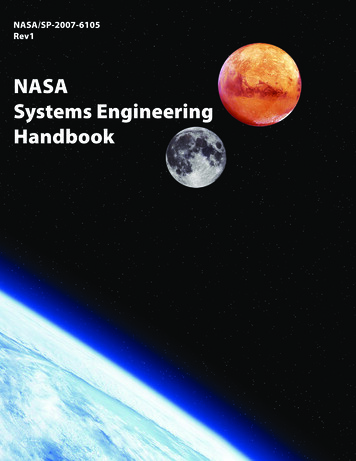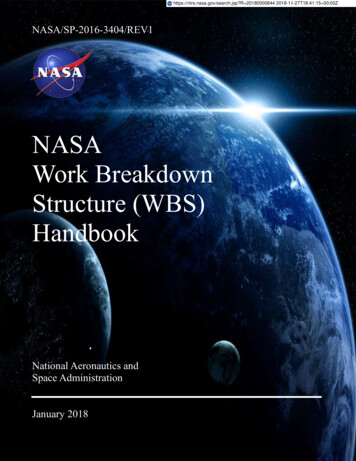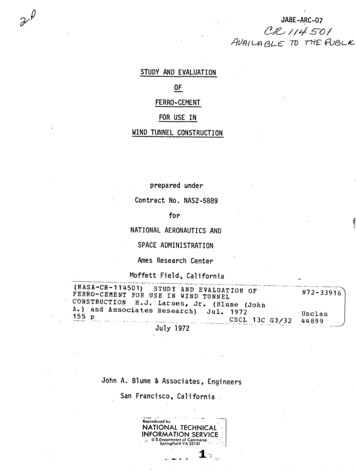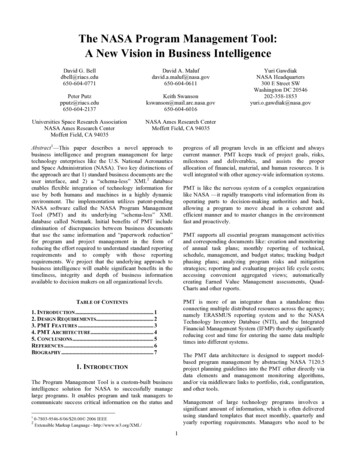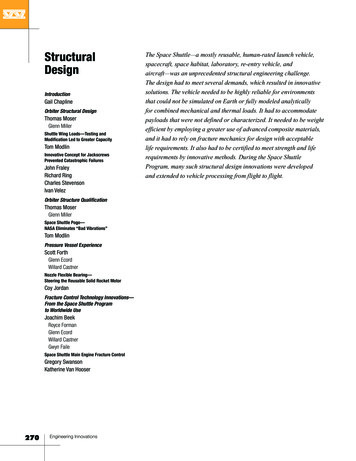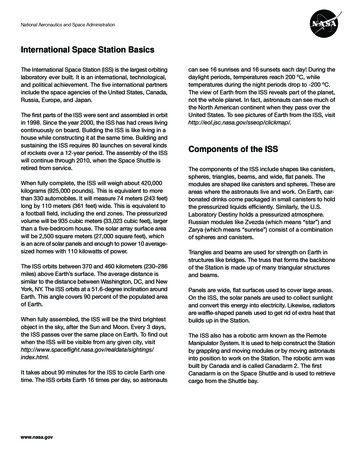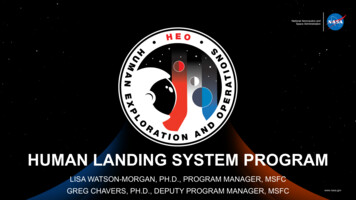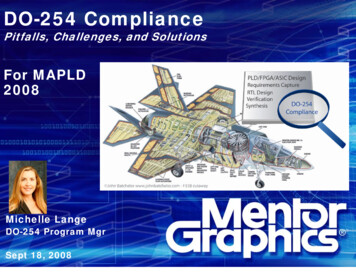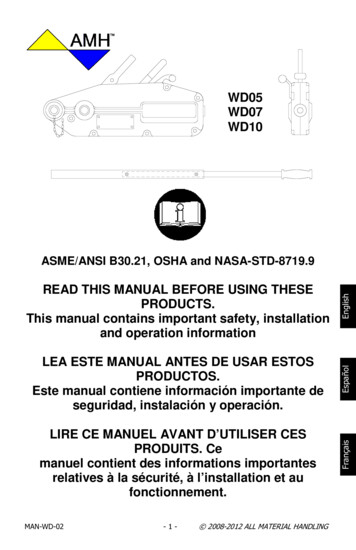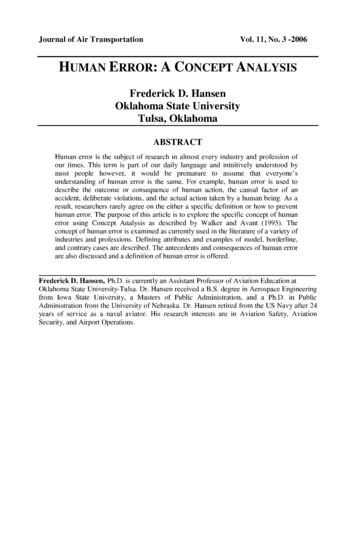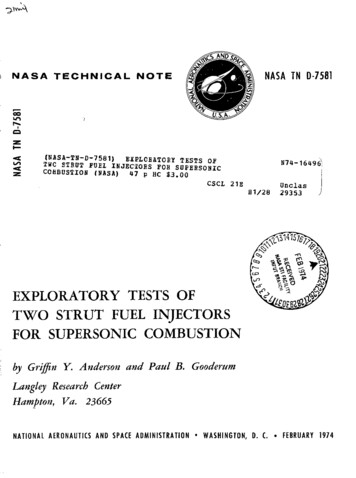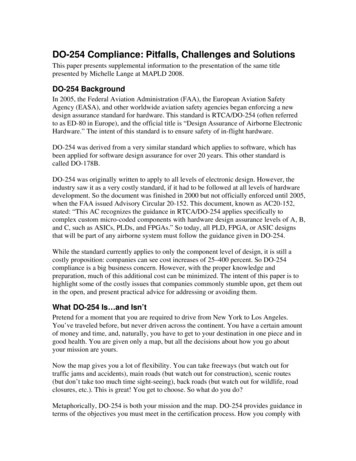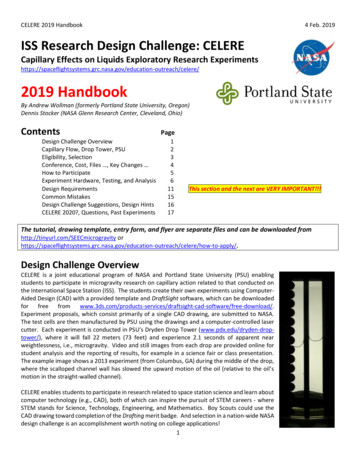
Transcription
CELERE 2019 Handbook4 Feb. 2019ISS Research Design Challenge: CELERECapillary Effects on Liquids Exploratory Research /education-outreach/celere/2019 HandbookBy Andrew Wollman (formerly Portland State University, Oregon)Dennis Stocker (NASA Glenn Research Center, Cleveland, Ohio)ContentsDesign Challenge OverviewCapillary Flow, Drop Tower, PSUEligibility, SelectionConference, Cost, Files , Key Changes How to ParticipateExperiment Hardware, Testing, and AnalysisDesign RequirementsCommon MistakesDesign Challenge Suggestions, Design HintsCELERE 2020?, Questions, Past ExperimentsPage12345611151617This section and the next are VERY IMPORTANT!!!The tutorial, drawing template, entry form, and flyer are separate files and can be downloaded fromhttp://tinyurl.com/SEECmicrogravity n-outreach/celere/how-to-apply/.Design Challenge OverviewCELERE is a joint educational program of NASA and Portland State University (PSU) enablingstudents to participate in microgravity research on capillary action related to that conducted onthe International Space Station (ISS). The students create their own experiments using ComputerAided Design (CAD) with a provided template and DraftSight software, which can be downloadedfor free from are/free-download/.Experiment proposals, which consist primarily of a single CAD drawing, are submitted to NASA.The test cells are then manufactured by PSU using the drawings and a computer-controlled lasercutter. Each experiment is conducted in PSU’s Dryden Drop Tower (www.pdx.edu/dryden-droptower/), where it will fall 22 meters (73 feet) and experience 2.1 seconds of apparent nearweightlessness, i.e., microgravity. Video and still images from each drop are provided online forstudent analysis and the reporting of results, for example in a science fair or class presentation.The example image shows a 2013 experiment (from Columbus, GA) during the middle of the drop,where the scalloped channel wall has slowed the upward motion of the oil (relative to the oil’smotion in the straight-walled channel).CELERE enables students to participate in research related to space station science and learn aboutcomputer technology (e.g., CAD), both of which can inspire the pursuit of STEM careers - whereSTEM stands for Science, Technology, Engineering, and Mathematics. Boy Scouts could use theCAD drawing toward completion of the Drafting merit badge. And selection in a nation-wide NASAdesign challenge is an accomplishment worth noting on college applications!1
CELERE 2019 Handbook4 Feb. 2019Capillary ActionNASA is very interested in capillary action because of its importance in liquid systems on spacecraft. On Earth, liquidsnaturally flow downward because of gravity and equipment is designed and built to take advantage of that natural process.For example, cars draw gasoline from the bottom of the fuel tank. But in microgravity, liquids naturally flow because ofcapillary action making it important for propellant, water processing, thermal control systems – as well as in somematerials processing.Capillary action happens when the molecules of a liquid (like water) are more attracted to a surface than to each other. Inpaper towels, the molecules move along tiny fibers. In plants (like celery), they move upward through narrow tubes calledcapillaries. For more basic information about capillary action, see for se/surten2.html#c4Capillary action can be difficult to observe on Earth because of gravity, except in small capillaries. But while experimentsfall in a drop tower, where there seems to be almost no gravity, capillary effects are easy to see and study.Drop TowerIn PSU’s Dryden Drop Tower, your experiment will be dropped down a tall shaft and while it is falling,it will behave as if there is nearly no gravity – of course neglecting the fall! Gravity will still bepresent, but our sensation of gravity and weight comes from a resistance to its pull, for examplebecause of the floor holding us up. But while freely falling, we feel weightless and that is the basisfor many amusement park rides. This works because of the surprising situation where all objectsfall at the same acceleration unless acted upon by another force. As one result, the astronauts andthe International Space Station fall together (around the Earth) such that the astronauts float withinthe space station. This happens even though the space station is so close to the Earth that gravitythere (in a low-Earth orbit) is only about 10% less than that on the planet’s surface. While this isspace science, the concept of apparent near weightlessness through free fall, i.e., microgravity, wasput to practical use in the late 1700s when shot towers were first built to produce superior shot forhunting. In those towers, droplets of liquid lead became spherical because of the surface tensionresulting from the liquid’s attraction to itself. You can learn more about microgravity ��s Prof. Mark Weislogel slogel) is a world leader in the study of capillary action and with NASA support has hadsuch experiments conducted in drop towers, on the space shuttle, on the Russian Mirspace station, and the International Space Station (ISS) where the following are twoexamples of his ISS experiments:Capillary Channel Flow F/Capillary Flow Experiment (CFE) http://issresearchproject.grc.nasa.gov/MWA/CFE/Now you can design your own microgravity experiment and investigate capillary actionjust like Prof. Weislogel and the astronauts. Begin by visiting the CELERE web site n-outreach/celere/ and reading thisguide!2
CELERE 2019 Handbook4 Feb. 2019Many astronauts have participated in microgravity studies of capillary action, including for example the following for CFE:Joe Acaba, Clay Anderson, Dan Burbank, Chris Cassidy, Cady Coleman, Tracy Caldwell Dyson, Mike Fincke, Kevin Ford, MikeFossum, Mike Hopkins, Scott Kelly, Mike Lopez-Alegria, Bill McArthur, Tom Marshburn, Karen Nyberg, Don Pettit, ShannonWalker, Peggy Whitson, Jeff Williams, and Sunita Williams (shown above operating CFE on the space station).EligibilityThe design challenge is for youth in grades 8-12, who may participate as individuals or in teams of any size. Teams mayalso include younger students as long as there is at least one team member in grades 8-12, where this option can facilitatethe participation of informal science clubs, Scouts, etc. Youth are free to get help from adults, for example in creatingtheir CAD drawing. But this program is for youth.The program is limited to students from the United States. It is open to all fifty states, the District of Columbia, PuertoRico, American Samoa, Guam, the Northern Mariana Islands, and the U.S. Virgin Islands. Students in other countries –even if U.S. citizens - are ineligible, with the exception of those attending DODEA schools for the children of U.S. militarypersonnel.Whether as an individual participant or team member, a student may be associated with at most a single CELERE 2019proposal. Furthermore, a maximum of 7 experiment proposals may be submitted to NASA by a single school ororganization for the 2019 challenge. But organizations can have greater participation if they prescreen the proposals andonly forward what they believe to be the best to NASA.SelectionSince the initiation of this design challenge, 100% of the entries received were selected for fabrication and testing inmicrogravity. However, this was often after the teams were directed to revise their CAD drawings because they failed tomeet the design requirements specified in this document. Please know that 2019 submissions which violate the designrequirements may be rejected to reduce the NASA and PSU workload associated with the challenge.Revisions were requested of roughly one third of the CELERE entries submitted last year, so close attention should be paidto the design requirements and common mistakes described in this document. Failure to do so may easily lead torejection.NASA will not check drawings to make sure that they are acceptable prior to the entry deadline, but will answer questionsabout the design requirements. Nonetheless, it is the submitting team’s responsibility to review this document and ensurethat the requirements are met.3
CELERE 2019 Handbook4 Feb. 2019If the design and submission requirements are met, the odds of selection in 2019 are quite high, where at least onequalifying entry is guaranteed for each state, etc. listed under ‘Eligibility.’ This guarantee includes selection of at least onequalifying entry from an overseas DODEA school. Selection is also guaranteed for at least one qualifying entry from aBureau of Indian Education (BIE) school. In past years, i.e., 2013-2018, there have only been participants from 20 states,Puerto Rico, and one overseas DODEA school (in Germany), so your entry could easily be the first from your locale.ConferenceA small number of CELERE participants - based on their experiment design, data analysis, and written report - will beinvited to present their results in a student poster session at the 2019 meeting of the American Society for Gravitationaland Space Research (ASGSR, www.asgsr.org) on Sat., November 23. It is expected that limited financial support will beavailable to help the invited non-local students travel to Denver, Colorado for this purpose.CostThere is no cost to participate in CELERE other than the optional conference travel.Files & Educational ResourcesAccess CELERE files and various educational resources related to microgravity via http://tinyurl.com/SEECmicrogravity.Key Changes from 2018 The 2019 schedule has been adjusted as a result of the partial shutdown of the federal government. Thesubmission deadlines for 2019 are:o March 10proposal (i.e., CAD drawing and entry form)o May 5written report on the resultsThe proposal, report, and other communication with NASA must be in English.The drawing template has been updated. Please use the 2019 drawing template which can be downloaded elere/how-to-apply/The other supporting documents – including this handbook, the tutorial, and entry form - have also been updated.The freely-downloadable DraftSight software upon which the tutorial is based has been and continues to beupdated.4
CELERE 2019 Handbook4 Feb. 2019How to Participate Preparation and SubmissionooooooooooooooExplore the CELERE website at http://spaceflightsystems.grc.nasa.gov/CELERE/.If you are a Facebook user, ‘like’ the CELERE page at www.facebook.com/NASA.celere.Read this handbook.Learn about capillary action, e.g., through: http://ga.water.usgs.gov/edu/capillaryaction.html .html#c4 1.htmlReview past experiments through the appendix of this handbook at a minimum, and ideally n-outreach/celere/celere-videos/.Download the CELERE 2018 tutorial from utreach/celere/how-to-apply/.Download the 2019 drawing template from utreach/celere/how-to-apply/. The use of past templates is unacceptable.From ad-software/free-download/, download theDraftsight CAD software and go through the CELERE tutorial. You may use other CAD software that workswith ‘dwg’ files, but the tutorial is based on the free Draftsight software.Review the design requirements and common mistakes in this handbook.Develop your research question.Design your test cell so that (1) the results will answer your research question and (2) it is different fromthe past CELERE experiments shown in the appendix.Download the entry form from outreach/celere/howto-apply/ and fill it out.Verify that all design requirements are fully met or risk rejection!E-mail the drawing file and entry form to celere@lists.nasa.gov (where this step might be done by yourteacher/advisor) by March 10. Testing and AnalysisooooSelected experiments are normally conducted during the month of their submission deadline.When notified, download the results from http://celere.mme.pdx.edu/. Note that the video files are notstandard, but can be viewed using VLC Media Player, which can be freely downloaded fromhttp://www.videolan.org/vlc/index.html.Analyze the results by comparing the capillary motion in your test cell’s channels. You can determine theposition of the oil in each channel as a function of time (e.g., knowing that high-speed video includes 60frames per second). The position can be determined in pixels, e.g., using Microsoft Paint, which showsthe position of the crosshairs in pixels, and then converted later into millimeters.From the position data, average speeds can easily be determined. ReportingooPrepare a written report about what you learned, and e-mail it by May 5 to celere@lists.nasa.gov (wherethe submission might be done by your teacher/advisor). The report should include discussion of whatwas good about the CELERE design challenge and what needs improvement.If invited, optionally present your results in a student poster session at the 2019 meeting of the AmericanSociety for Gravitational and Space Research (ASGSR, www.asgsr.org) on Sat., Nov. 23. It is expected thatlimited finan
04.02.2019 · requirements may be rejected to reduce the NASA and PSU workload associated with the challenge. Revisions were requested of roughly one third of the CELERE entries submitted last year, so close attention should be paid to the design requirements and common mistakes described in this document. Failure to do so may easily lead to rejection.
